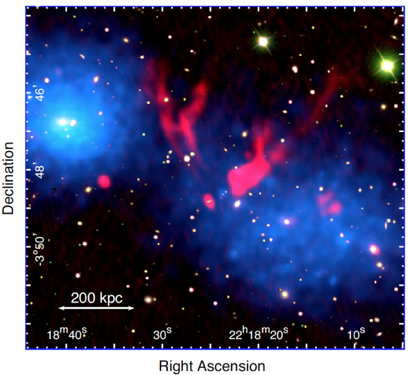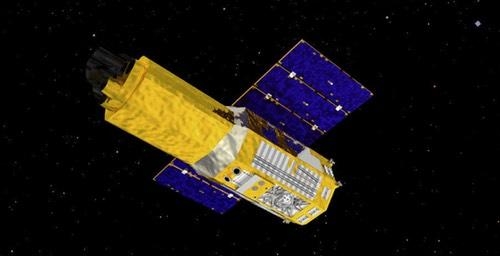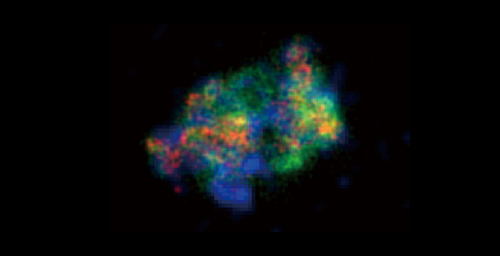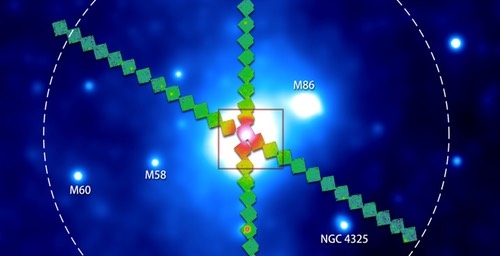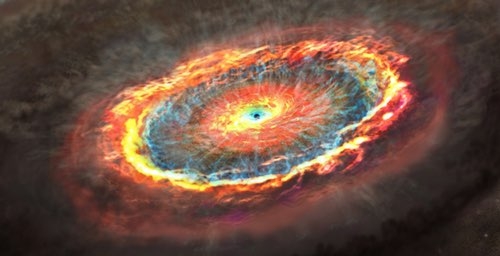For the first time, astronomers have found two giant clusters of galaxies that are just about to collide. This observation can be seen as a missing 'piece of the puzzle' in our understanding of the formation of structure in the Universe, because large-scale structures of the Universe are thought to grow by merging processes between clusters and groups of galaxies. The result was published in Nature Astronomy.
Clusters of galaxies are the largest known bound objects and consist of hundreds of galaxies that each contain hundreds of billions of stars. Ever since the Big Bang, these objects have been growing by colliding and merging with each other. Due to their large size, with diameters of a few million light years, these collisions can take about billions of years to complete. After this time, the two colliding clusters will have merged into one bigger cluster.
Because the merging process takes much longer than a human lifetime, we can only see snapshots of the various stages of these collisions. The challenge is to find colliding clusters that are just at the stage of first touching each other. In theory, this stage has a relatively short duration and is therefore hard to find. According to the reading author of this paper Dr. Liyi Gu (RIKEN), "it is like finding a raindrop that just touches the water surface for the first time in a photograph of a pond during a rain shower." Obviously, such a picture would show many falling droplets and ripples on the water surface, but only few droplets in the process of merging with the pond. Similarly, astronomers found a lot of single clusters and merged clusters with outgoing ripples indicating a past collision, but it is very rate to find two clusters that were just about to touch each other. In 2016, an international team of astronomers discovered two clusters of galaxies at the verge of colliding based on observations by the X-ray telescopes Suzaku and XMM-Newton.
The team of astronomers now announces the first detection of shock waves created by the collision of the clusters of galaxies. This enables astronomers to test their computer simulations, which show that in the first moments a shock wave is created in between the clusters and travels out perpendicular to the merging axis. "These clusters show the first clear evidence for this type of merger shock", says Dr. Gu. "The shock created a hot belt region of 100-million-degree gas between the clusters, which is expected to extend up to, or even go beyond the boundary of the giant clusters. Therefore, the observed shock has a huge impact on the evolution of galaxy clusters and large scale structures."
Astronomers are planning to collect more 'snapshots' to ultimately build up a continuous model describing the evolution of cluster mergers. SRON-researcher Hiroki Akamatsu: "More merger clusters like this one will be found by eROSITA, an X-ray all-sky survey mission that will be launched this year. Two other upcoming X-ray missions, XRISM and Athena, will help us understand the role of these colossal merger shocks in the structure formation history."
Liyi Gu and his collaborators studied the colliding pair during an observation campaign, carried out with three X-ray satellites (ESA's XMM-Newton satellite, the NASA's Chandra satellite, and JAXA's Suzaku satellite)and two radio telescopes (the Low-Frequency Array, a European project led by the Netherlands, and the Giant Metrewave Radio Telescope operated by National Centre for Radio Astrophysics of India).
Figure caption: Composite image showing radio at 325 MHz from GMRT (red), optical and X-rayemission from Chandra X-ray Observatory (blue) of the two clusters of galaxies. The background image shows the optical data from the Sloan Digital Sky Survey.
The same images were used to create the animation.
The animation illustrates the process of a major merger by putting together a set of clusters observed at different merger stages, ordered by the core-to-core distances. The X-ray image (blue) is overlaid with the radio image (red) for each object. The third row from the top shows the object reported in the paper.
Paper: Gu, Akamatsu, Shimwell et al., 2019, Nature Astronomy,
"Observations of a Pre-Merger Shock in Colliding Clusters of Galaxies"
DOI: 10.1038/s41550-019-0798-8

